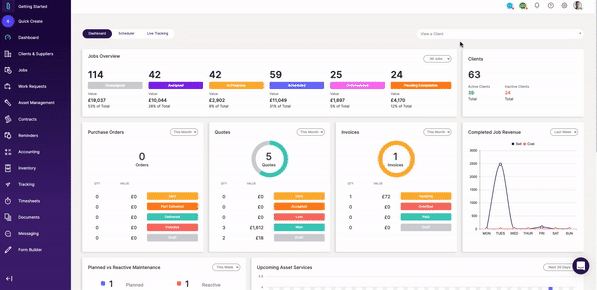Managing the Planned Preventative Schedules (PPM) for Medical Equipment requires you to be extremely organsied and Healthcare CMMS helps you achieve this and meet customer demands.
To ensure healthcare clients are able to offer excellent levels of patient care using medical devices, it’s vital these are serviced regularly. Medical equipment maintenance businesses are turning to Healthcare CMMS software to provide them with a way of more efficiently managing their teams and ensuring they never miss a scheduled service job.

What does CMMS mean?
If you work in the field of equipment maintenance then you will be most likely aware of CMMS software.
It’s a computerised maintenance management system (CMMS) that will streamline asset management, job scheduling, inventory management and more, by connecting all parts of the operation into one system.
For the Healthcare industry it’s especially important to make sure that equipment is fully operational and meets strict compliance standards. Lawsuits, fines, and even loss of life can occur should the equipment fail at a vital time.
Medical Facilities put the reliability and ongoing maintenance in the hands of medical equipment maintenance specialists and many of those businesses use Healthcare CMMS software to ensure the work is carried out correctly.
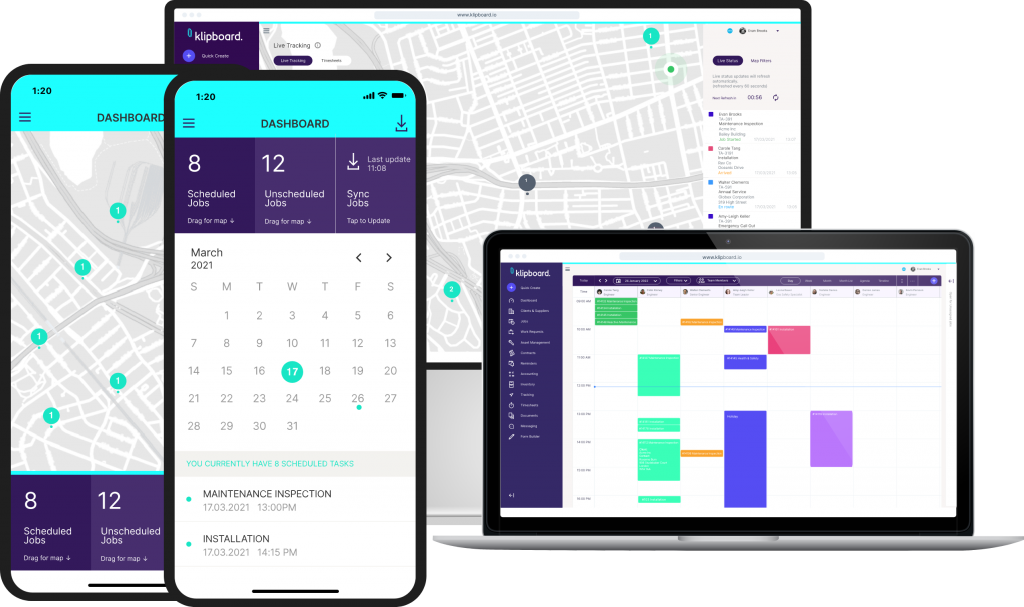
Advantages of using a Healthcare CMMS
Any business managing the planned servicing of assets will notice a boost in productivity and efficiency gains by using CMMS.
Your job scheduling, asset and inventory management, customer communications will be streamlined or automated by using CMMS, saving you time and resources.
Here are some of the key advantages of using a healthcare CMMS:
Increased work order efficiency
- Quickly assign the next available engineer to a job by having greater visibility of work schedules
- Easily adjust schedules to maximise the use of your field team’s time
- Prioritise jobs to ensure urgent work is carried out first
Improved customer experience
- Automated customer communications provide consistent and professional updates
- Client Portals helps improve job progress visibility
- Export completed job details into branded, professional looking PDFs and send them directly to the client
Complete more jobs
- Work order reminders help notify the client of a due service
- Services unlikely to be missed when all parties are kept informed
- Visibility of parts and asset details help jobs get completed on schedule
Insure asset compliance
- Planned Maintenance schedules ensure equipment is kept up to code
- Greater ability to track the causes of previous faults or breakdowns
- Mandatory check lists on forms ensure all checks are made
- All details are documented and archived for auditing
Greater Asset Reliability
- Reduce asset downtime
- Improved performance
- Extend the lifecycle of assets
Improved operational visibility
- Dynamic Dashboards provide real time information
- Gain greater insight into the profitability of each job
- Record the time spent on each job and traveling to each job
What features do Healthcare Servicing professionals need from a CMMS?
While CMMS software is used widely by various different industries and use cases, the Medical and Healthcare industry has some very specific requirements and priorities.

Asset Management
Asset Management most likely sits on top of the list of requirements. This is because of the compliance, codes and standards medical equipment has to meet to be suitable for patient use.
Medical Devices and Healthcare Equipment has to be inspected and serviced on a periodic basis and keeping up with the servicing schedule can be time consuming. Missing a service can have a significant effect on your customer’s ability to provide care.
Asset Management through a CMMS helps you to easily track the service dates of your customer’s assets. You can stay on top of your schedule, not miss any jobs and if a reactive job is called in you can build enough flexibility into your plan to cope. Read more.

Job Scheduling and Dispatch
CMMS systems allow you to create jobs or assign existing scheduled jobs to your team. You can pick the right person for the work by viewing at a glance who is available.
Once the Medical Servicing Technician has been assigned the job they will receive all the details they need on the client, their assets, any forms they need to complete, documentation and location details.
This greatly reduces the amount of time your back office needs to spend gathering documents, contact information and the forms they need to complete. Read more.
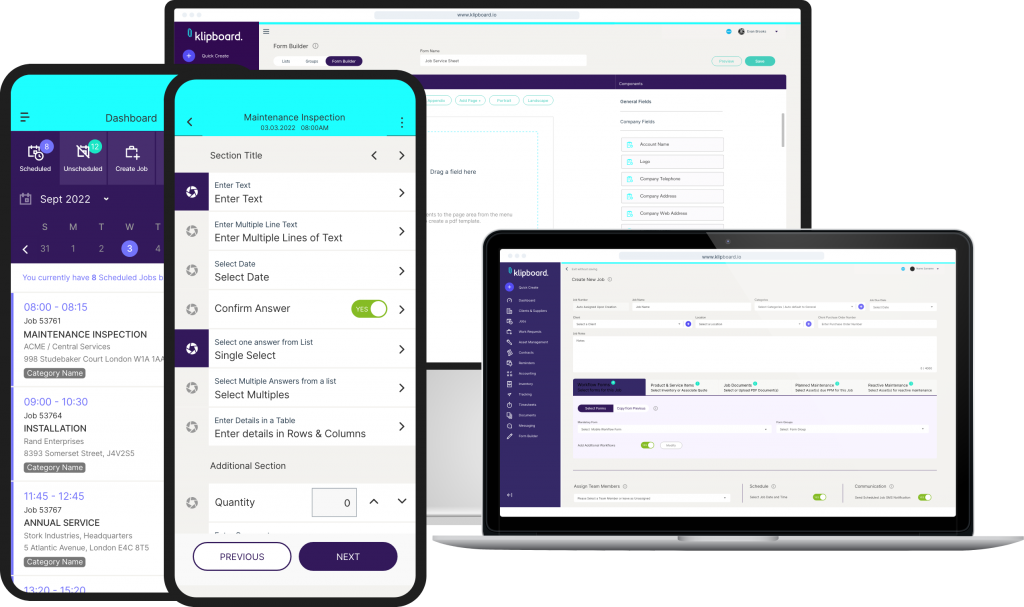
Digital Forms
Engineers do a lot on their smartphones and iPads nowadays. The rise in popularity of Job Management Software has encouraged more service businesses to make use of job apps rather than paper based forms or PDFs.
CMMS with Digital Form capabilities allow you to use templated forms or even build your own. Your Field Team can access the forms from their mobile phone or tablet, these include all the checks they need to make on the job and can include mandatory fields to make sure every important detail is checked. Read more.
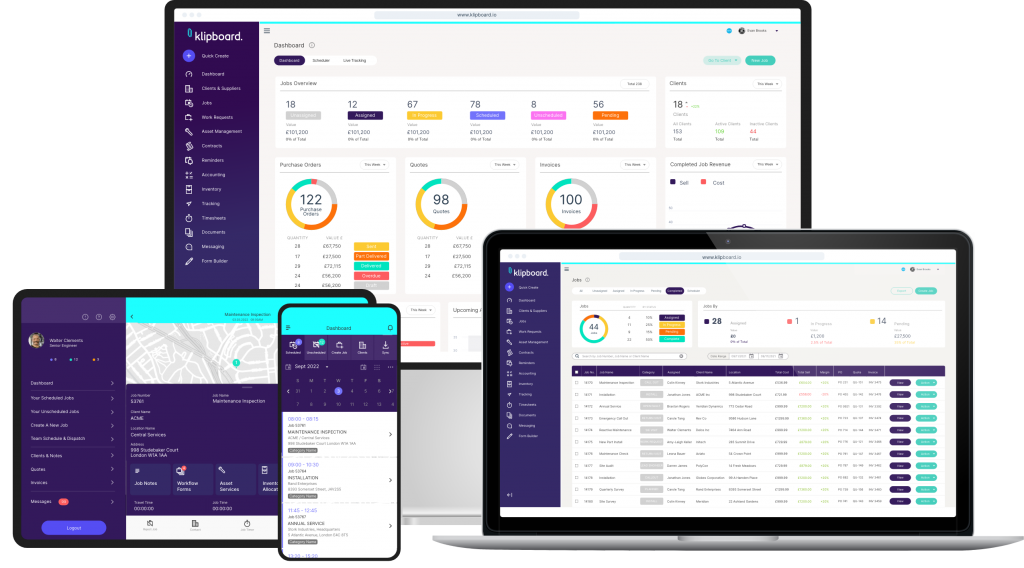
Real Time Dashboards
One of the key benefits of CMMS is the improved visibility it gives you on your servicing schedule and finances.
Real time Dashboards help visualise exactly what’s happening in your business. You can see statistical graphs on financial performance indicators. You can see your outstanding invoices, how many quotes are awaiting acceptance and the number of due and serviced assets on PPM schedules. Read more.
Automated Customer Communication
You can give your customers an Uber-like experience with automated SMS and Email communication. Healthcare CMMS helps you meet the expectations of the modern customer by giving you the ability to create automated job booking confirmations, messages to let them know you’re on route, feedback requests and more. Spend less time managing emails, messages and responses and more time on the actual jobs. Read more.
Healthcare CMMS software vs Emails, Spreadsheets and Diary Management
A medical equipment maintenance business could carry out their servicing schedule using emails, spreadsheets and a diary. There’s some advantages to using something as simple as an email but what you gain in simplicity you lose in efficiency.
Job Scheduling with Emails and a Diary
Everyone has email. It’s very accessible and simple to set up.
When a job comes in and you’re managing your medical equipment servicing scheduling using email you can write out the email, attach documents and send that to the engineer.
The downside is you need to write out all of the job details, you need to collect all the documents, manuals, inventory lists and attach the correct job forms. Tasks that are this manual leave your business vulnerable to human error and mistakes.
You still have to find a slot available in your diary for the work. Without a single source of truth in your business you could easily double book an engineer or miss out assigning a more suitable person to the job.
This can lead to delays in getting the work completed and a poor experience for the customer.
Job Scheduling with a Healthcare CMMS
By using Healthcare CMMS software to manage your job scheduling you’re enabling your team to be responsive. They will be able to react when an unplanned job is requested by viewing who is available and adjusting the schedule to accommodate the work request.
Without a CMMS system you’re simply accepting the job and presuming someone can be made available or your viewing a schedule that might not be accurate, leading to double bookings.
One click and you can see who has room in the schedule in an instant. Then assigning them the job will automatically send over all the information they need to complete the job such as the correct job forms to fill out on their smartphone, any manuals or documentation needed for the asset, floorplans, customer details, location routing.
This is all handled by the CMMS system so there’s little room for mistakes which can cost an engineer a lot of time.
Completing Job Forms with PDFs or Paper Forms
Any medical equipment maintenance business still completing jobs in the field using paper based, carbon triplicate forms, is most likely well aware of their need to modernise their business.
Even using PDF forms or spreadsheets is an old fashioned way of working. It’s over reliant on the field engineer having the correct and most up to date form on their device or the back office team needs to make sure they are sending the correct forms to the engineer.
Mistakes made with job forms can cause miscommunication and tension between your teams, it’s easily avoidable and a common reason for jobs being delayed.
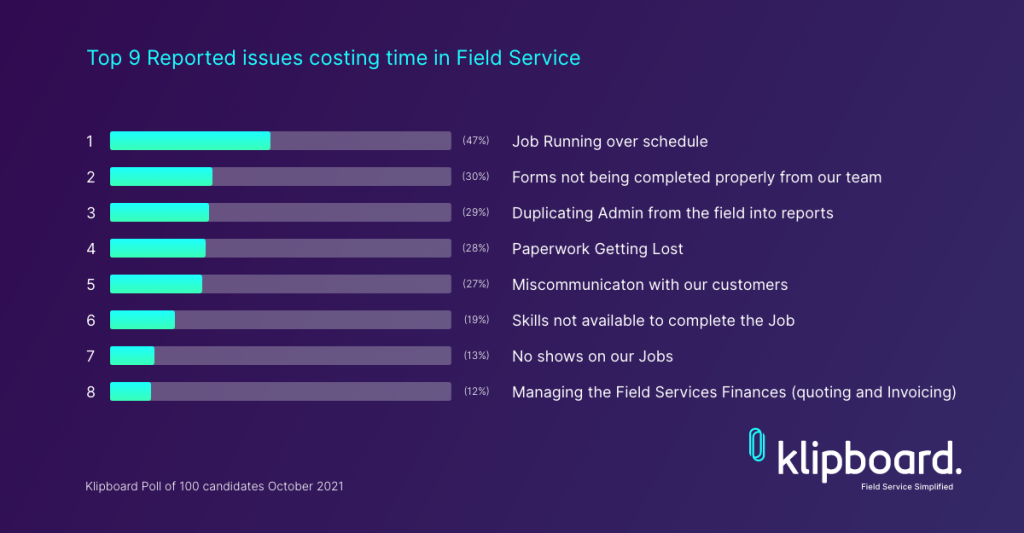
In a survey of 100 Field Service professionals, 30% of them said ‘forms not completed properly’ was a key reason for lost time on Field Service jobs.
Completing Job Forms with Healthcare CMMS
Once you’ve assigned the right person for the job and they are with the customer completing the inspection, repair or survey, they will need to complete checklists, add notes and get sign off from the customer.
Using a Healthcare CMMS system allows your field engineer to complete the job on their phone. When they are assigned the job the CMMS will send over digital job forms for them to complete.
By syncing their device with your CMMS they are able to use the most up to date information. These forms are either standard checks to meet compliance standards using built-in templates or they can be quickly and easily built by your team using a drag and drop system.
The future of field service for medical equipment maintenance is allowing your team to build exactly what they need for their jobs and standardising the output of their work. It’s consistent, up to date and more efficient.
Mandatory fields can be included to make sure every detail is covered, photo evidence or voice dictation can be gathered and attached to the job, then the customer can sign off the work, directly onto their smartphone.
This information is instantly synced back to the office, ready for reports, audits and raising the invoice. This is field service for Medical equipment streamlined.
Writing up reports after completing a job
Engineers work long hours. They are expected to travel to customer locations, complete complex work on medical equipment that’s vital to their customers’ business.
When the job is done many engineers take the work home with them to write up a summary of the work completed. This adds extra hours to their day, creates a poor work/life balance and extends the time it takes for a Medical Equipment Maintenance business to send out an invoice for the job.
Manually completing reports encourages inconsistency with your team’s output. What one engineer might include could be omitted by the next. You may not notice it but your customer will and that leads to a poor experience for them.
Producing reports after a job using Healthcare CMMS
Once the work is complete the engineer needs to produce a summary of the work. Normally this would involve typing up reams of notes, listening back through dictation or worse still have to remember the details if they are correctly written down.
By using Healthcare CMMS the engineer has everything they need the minute the job is signed off. All the details collected on the job using the mobile forms can be instantly converted into a PDF report for the customer.
These branded PDF reports use the fields in your forms to create a consistent and professional looking summary of work carried out, recommendations or even an itemised summary of parts used.
The biggest advantage to using a CMMS is the pressure this takes off the engineer. They no longer need to take their work home with them or back to the office to write up which extends the time it takes to invoice for a completed job.

How much it can cost medical facilities if their medical equipment fails to meet compliance standards
The reason why so many medical facilities are keen to work with medical equipment maintenance partners is the cost of failing to meet compliance standards can be high.
It’s unlikely to happen but the potential for a fine by failing to ensure patient wellbeing with medical devices is ever present and the risk too great for the reputation of the medical facility.
In 2021 the HIPAA resolution agreements from the Department of Health and Human Services (HHS) issued fines totalling $6 million dollars and $13.5 million in 2020. Not all of these fines were from defective equipment however, many of them were and these were avoidable with the correct procedures in place to ensure regular and routine maintenance.
To meet the demands of your customers you’ll need to streamline your processes, remove complexity, take human error out of the equation and give your field team the tools to complete their service schedule.
You’ll need to ensure you can assign the right people to the right jobs, have a clear view of your upcoming service schedule and be able to access information at a moment’s notice. That’s what Healthcare CMMS software can help you achieve.
Healthcare CMMS Frequently Asked Questions
Can you try out CMMS for Free?
Some providers offer a Free Trial period of their software while others choose not to.
It’s important to do your research first and make sure the feature set of the software provider covers all your basic needs. There may be some unique complexity to your business that you will need to discuss with the CMMS or Job Management Software provider.
In the first instance check they have the basics in terms of features then start a Free Trial to see how it will work for your business.
What is the difference between Cloud based CMMS and on-premise CMMS?
The main different between Cloud based and on-premise CMMS is where the software is hosted. On-premise software has to be stored, managed and updated locally, on your server network. Cloud based is hosted by the software vendor and accessed anywhere via a web browser or mobile app.
How do you implement a CMMS?
Adding something as compressive as a CMMS can feel daunting at first, after-all your expectations are that this software will improve a lot of what you do day to day.
Software has come a long way since the days you needed to bring in IT specialists and build a new server just to run your job management software.
Cloud based options software has presented businesses with software options that can be instantly accessed from the web and doesn’t require you to experience a lengthy set-up or disrupt your office.
Here are some common questions answered when service businesses implement a CMMS.
Do I need to do anything before implementing a CMMS?
Once you’ve been on a few demos and picked a software provider you’ll need to do a little homework before the implementation begins.
Although your software provider will assist you with the implementation and onboarding of the CMMS, there are a few things you need to do such as:
- Get your team onboard. Your Field Technicians and back office teams will need to be consulted to highlight any specific role they carry out that might need to be considered for the CMMS.
- Gather your data. Unless you are starting with a clean slate you will most likely need to incorporate your existing customer records into the CMMS. Your provider will give you instructions and its worth noting you may wish to do this, so prepare your data.
- Pick your champions. While it’s worth getting advice from around the business on the requirements of the CMMS, it’s also advantageous to pick a few people from around your business who will become your CMMS experts.
How long does it take to implement a CMMS?
This is dependent on the provider you choose, the size of your business and the features you need to use to run your business. In most cases it’s around 4-8 weeks.
While Cloud based software is instantly accessible, software providers who want you and your team to get the most out of the system may require some of your time to ensure proper training is completed.
It’s also important that your customer contact details and any asset registers are integrated into the new system.
Top tip: Before committing to a CMMS provider ask them about the implementation and onboarding they offer.
How user friendly is CMMS software?
In most cases CMMS systems are built with the user in mind. You need to make sure your team is comfortable switching from one way of working to another.
Modern CMMS systems look a lot less like spreadsheets and dull pie charts and more like the bright, intuitive software you would expect. Data visualization helps bring details of your servicing business to life and the digital forms your team uses in the field are simple to build and easy to use.
Can I import my Asset Register into my CMMS?
If you need to import your customers assets into your new Healthcare CMMS system you may need to do a bulk import. Software providers may handle this process differently but most, including Klipboard all you to do it by Location, Location ID or by Client.
